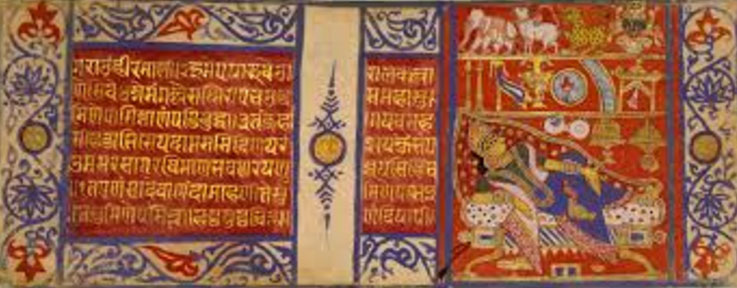Jain Paintings
Historical Background
Wall Paintings
 |
The wall-paintings of Ajanta, Bagh and Sittannavasal are religious in the sense that the first two decorate Buddhist Viharas and the third a Jain temple and therefore, they had to conform to certain religious traditions and certain hide-bound formulas peculiar to each faith. Of the frankly secular art which delighted in portraiture we have no trace. Let us, therefore, see what the Jain literature has to say about painting.
The legendary account attributes the origin of the art of painting (chittakamma) to Rshabhadeva, the first Jain Tirthankara, from who are also said to have originated the sciences of mathematics and symbology. As painting originated from Rshabha himself the profession of a painter was not stigmatised. A painter (chittara) was counted among the Silparyas and his profession was held to be a noble one.
In the formative period of the Jain church, monks, in common with the Buddhist monks, were forbidden to live in the house decorated with painting. This injunction seems to have been due to the sensuous appeal of painting which detracted the minds bent upon meditation. Thus it is mentioned in the Uttaradhyayana Sutra that a Jain monk did not like to live in a beautiful house decorated with painting, fumigated and perfumed with incense and flower garlands, and fitted with doors and white ceiling. At another place, it is enjoined that a monk should not look towards the figure of a woman either in a painting or actual life. In the Brihat Kalpasutra a ban is laid upon the monks and nuns indulging in the art of painting (sachitta kamma.) In the Bhasya, however, which is a much later work, the subject of painting is divided under two heads-(1) Nirdosha chitra-karma or pure painting consists of painting of trees, mountains, rivers, seas, buildings, creepers, Purna-Kalasa, Svastika, etc; (2) the Sadosha chitra or impure paintings are those of flying figures, goddesses and ordinary women. The practice of both kinds of paintings was forbidden to monks. This injunction, however, seems to have been relaxed in the middle ages when the Jain Jnana Bhandars became the repositories of many painted manuscripts and banners.
There are numerous references in Jain literature which give interesting descriptions of the decorative motifs and the technical process involved in painting, and also good descriptions of picture galleries. Thus it is mentioned at one place that the ceiling of Dharinidevi's palace was painted with lotus rhizomes and flowering creepers phullavalli-vara-puppha-jai-ulloya-chittaya-tale. At another place very interesting details of the construction of a picture gallery are given. Malladinna, the crown prince of Mithila, ordered the erection of a picture gallery (chitta-sabha) at the royal amusement part. He entrusted the work of painting to a painters guild (chittagarasenim) and asked its members to paint the gallery in such a way that the forms (ruvehi) should be frankly sensuous. The painters taking their brushes (tuliao) and colours (vannae) proceeded to the proposed picture gallery. There they divided the wall-surface (bhumibhage) and prepared the ground (bhumi sajjei). One of the master painters was so gifted that he could paint complete figures of man and animals even if he had only their partial view. This rare gift nearly ended in a tragedy. The painter once had the glimpse of the toes of Princess Malli protruding from behind the curtain and was able to paint her full portrait. The crown prince doubting the chastity of his sister banished him from his kingdom.
-----------------------------------------------------
Source : Jain Paintings By : Shri S. M. Nawab
-----------------------------------------------------
Mail to : Ahimsa Foundation
www.jainsamaj.org
R150203